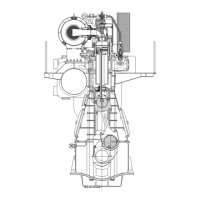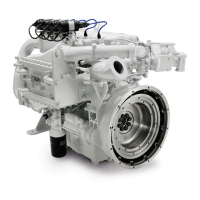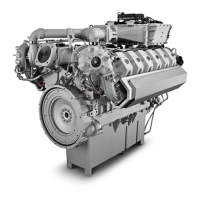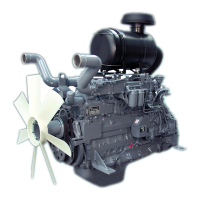Calculation of List of Capacities and Exhaust Gas Data
This chapter describes the necessary auxiliary ma-
chinery capacities to be used for a nominally rated
engine. The capacities given are valid for seawater
cooling system and central cooling water system,
respectively. For derated engine, i.e. with a speci-
ed MCR and/or matching point different from the
nominally rated MCR point, the list of capacities
will be different from the nominal capacities.
Furthermore, among others, the exhaust gas data
depends on the ambient temperature conditions.
Based on examples for a derated engine, the way
of how to calculate the derated capacities, fresh-
water production and exhaust gas amounts and
temperatures will be described in details.
Nomenclature
In the following description and examples of the auxiliary machinery capacities, freshwater generator pro-
Engine ratings Point / Index Power Speed
Nominal MCR point L
P
L
n
L
Specied MCR point M P
M
n
M
Matching point O P
O
n
O
Service point S P
S
n
S
Parameters
Q = Heat dissipation
V = Volume ow
M = Mass ow
T = Temperature
Cooler index
air scavenge air cooler
lub lube oil cooler
jw jacket water cooler
cent central cooler
Flow index
sw seawater ow
cw cooling/central water ow
exh exhaust gas
fw freshwater
Fig. 6.01.02: Nomenclature of coolers and volume ows, etc.
Engine congurations related to SFOC
For S70MEC/MEGI, L70MEC, S65MEC/MEGI, S60MEC/MEGI, L60MEC, S50MEC
The engine type is available in the following two
versions with respect to the efciency of the tur-
bocharger:
•
A) With high efciency turbocharger, case A:
which is the basic design and for which the lists
of capacities Section 6.03 are calculated.
• B) With conventional turbocharger, case B:
Which is an optional design (EoD No. 4 59 07)
if a higher exhaust gas temperature is required
for the exhaust gas boiler. This modication
will lead to a 78% reduction in the exhaust gas
amount and a temperature increase of about
20°C. The SFOC penalty will be 2 g/kWh, see
example in Fig. 6.0.03. The corresponding lists
of capacities are shown in Section 6.03.
198 96 824.5
Fig. 6.01.03: SFOC curves for (A) high efciency and
(B) conventional turbochargers, respectively
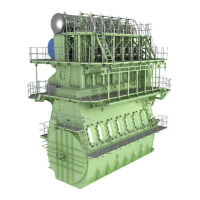
